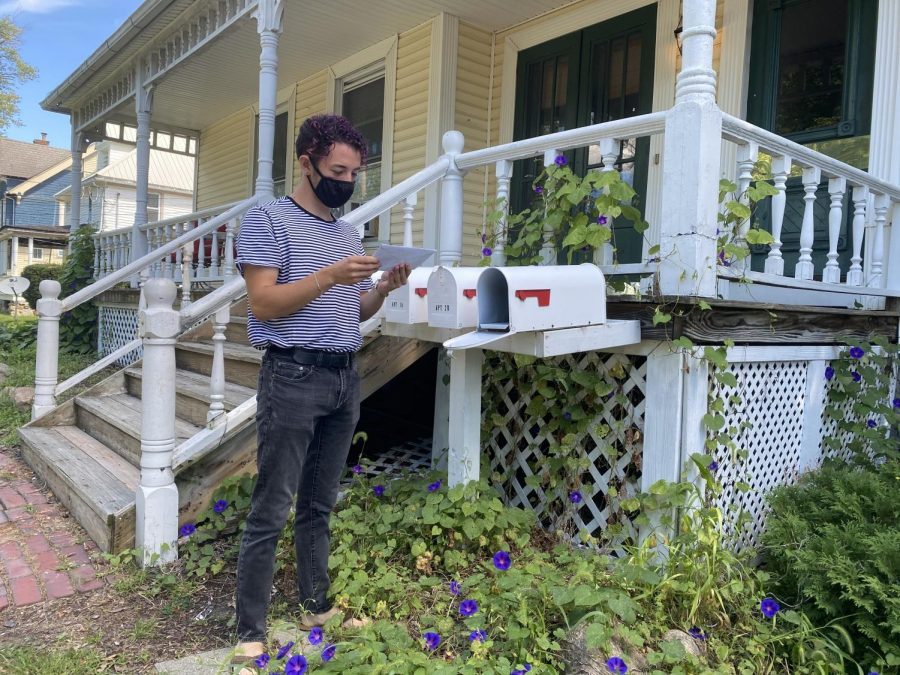Students and Faculty Work to Ensure Safe and Accessible Voting
College fourth-year Daniel Fleischer receives his absentee ballot in the mail. The College encourages all students to consider absentee voting this fall.
For remote and unenrolled students who wish to cast their ballots in Ohio, and for anyone who hopes to avoid long lines amidst the COVID-19 pandemic, absentee voting is the way to go this year. Therefore, many local advocates have refocused their efforts on helping students navigate the often-confusing process of voting by mail.
One group working on the problem is Voter Friendly Campus, a working group of faculty and staff that helps students register and vote. Usually, VFC works to promote a high student-voter turnout. Because most third-years aren’t on campus as part of the College’s three-semester plan, VFC is working to disseminate information about the multi-step process of requesting an absentee ballot.
This year they are also working to ensure that students have a safe voting experience.
Many public health experts are encouraging in-state voters to vote by mail this year by requesting an absentee ballot. Students must correctly fill out the request form and mail it to the Lorain County Board of Elections by October 31.
College third-year Annie Payne is currently working on the Shannon Freshour campaign, a Democrat running for Congress in Ohio’s 4th congressional district. She says that she has been answering many student questions about forms and deadlines.
“On our campaign specifically, we are reaching out to the colleges in our district, and I know we have brought on several Oberlin interns and volunteers, so we are definitely trying to tackle this issue by establishing a presence on campus,” Payne wrote in an email to the Review.
The College is also offering guidance to students to help them correctly fill out the voter registration form and vote absentee.
“Our Voter Friendly Campus (VFC) coalition is sponsoring virtual information sessions throughout the move-in period to walk students through the absentee ballot application process,” Assistant Vice President and Senior Associate Dean for Strategic Initiatives Adrian Bautista said in an email to the Review. “We’ve also spent much time working with the Office of Communications to update our ObiesVote website.”
In recent weeks, voting advocates around the country have also raised concerns about potential delays at the post office and boards of election that would result in some ballots going uncounted. Because of these concerns, the College is encouraging students to request the absentee ballot as soon possible.
“The sooner people sign up to do this, the better,” said Associate Professor of Geology and member of the working group Zeb Page. “They are expecting a large turnout for the election. The local Board of Election is not used to handling this many mail ballots, the postal service is not used to handling this many mail ballots … and so what we need to do is to get people to turn in these applications quickly so they can get their ballots quickly so they can turn them around and get them counted.”
Even though voting by mail is encouraged by the College administration and public health experts, students still have the option to vote in person if they have residence in Oberlin.
College fourth-year Claudia Olaes works on the #VotingIsSexy initiative, a group of students who register students and get them excited about voting. She talked to the head of the Lorain County Board of Elections about precautions in the fall.
“We want students to know they have options to vote for this November election, whether it’s an absentee ballot, voting in person at the Board of Election or voting at the polls such as Philips gym,” Olaes said. “There’s going to be safety and social distancing precautions that will be made for in-person voting such as everyone standing six feet apart, sanitation materials, and the layout has changed when separating the voting units.”
Before students can vote, they must be registered, which is an additional difficulty for groups that generally spend the first few weeks of school getting students signed up to vote.
“One of the other real tricks that we are dealing with is registering new students in Oberlin, either first-year students or people who have never registered to vote in Oberlin before. For the most part, voter registration is done by students or volunteers, and it’s something that you do face-to-face over a clipboard; it’s really not safe to do during the pandemic,” Page said.
Registering people to vote in Oberlin every year consistently presents a challenge. Ohio law requires people to re-register to vote every time they change residences — even if students are only moving from one dorm to another.
The law requiring students to re-register to vote every year has also caused third-year and remote students to wonder if they can vote in Ohio although they will not return to campus until after the election. Page assures these students that they are still eligible.
“This kind of goes straight to what exactly a residence is, and we are sort of in this unprecedented time, but I think an analogy could just be … if you are displaced by a natural disaster, and your place of residence is unavailable to you because of that, then I don’t think you should lose your franchise because you can’t maintain that exact address,” Page said.
To vote in the November election, students must register to vote by October 5, request a mail-in ballot by October 31, and have their ballot returned to the Lorain County Board of Election as early as possible before the November 3 deadline. For information about how to request an absentee ballot, check your voter registration status, change your voting address, and more, students can consult Page’s resource.







